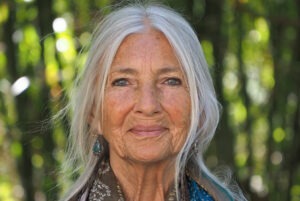 Geneviève De Coux was born in 1947 in Namur, Belgium during her parents’ holidays. The family lived in the Belgian Congo. Geneviève and her brother enjoyed an idyllic childhood until 1960, the year of the Congo’s independence. The family emigrated to Belgium.
Geneviève De Coux was born in 1947 in Namur, Belgium during her parents’ holidays. The family lived in the Belgian Congo. Geneviève and her brother enjoyed an idyllic childhood until 1960, the year of the Congo’s independence. The family emigrated to Belgium.
Their paradise was lost. Geneviève found herself in Brussels, this radical change of scenery stoked the fire of her ontological search and she found refuge in art. In 1968 during her second year at the university while studying her philosophy paper, she stumbled upon a saying of Socrates which hit her straight in the heart: “Know thyself”! Realising that this was precisely what she had always been looking for, she instantly dropped her studies and set out for India by road in search of a living Socrates or Buddha.
On reaching the Himalayan foot-hills, she led a meditative and ascetic life by the Ganges in Rishikesh, waiting to meet her master. The locals called her Mira because of her devoted renunciation. At the end of 1968, in circumstances well worthy of Indian mythology, she met a man with whom she had an awakening experience. He left the following day without Mira knowing anything about him, neither his name nor his address. The one certainty was that finally she had found her master. To give herself the best chance of seeing him again, she decided to live at the exact spot of their meeting. For eight months she waited for him and meditated under a little tree on the banks of the Ganga river.
One day, her master, H.W.L.Poonja, a disciple of Ramana Maharishi, came back for her. She became his disciple and wife and started to travel with him. In 1971, H.W.L Poonja was invited to give Satsang in Europe and Mira accompanied him. Their daughter Mukti was born in 1972 and the little family went on travelling the world. For the education of her daughter Mira returned to Belgium. In 1990, H.W.L Poonja, also called Papaji, settled permanently in Lucknow where he gave Satsang every day until he passed away in 1997.
In 1998, Mira was invited to give satsang, which she continues giving to this day all over the world. She decided to call herself Ganga. In 2004 Ganga Mira moved to Portugal. She lives near the wild ocean of the Algarve with her daughter Mukti and her grand-children, Arun and Satya, and gives satsang four times a week.
Website: gangamirasatsang.com
Interview conducted 5/21/2016
Video and audio below. Audio also available as a Podcast.
YouTube Video Chapters:
- 00:00:00 – Introduction to Buddha at the Gas Pump and Ganga Meera’s Background
- 00:03:27 – The Fascinating Journey to India
- 00:06:40 – Living Under the Tree
- 00:09:23 – The Power of Meeting the Master
- 00:12:41 – Increasing the Intensity of the Fire
- 00:17:07 – Remaining Connected to Papaji
- 00:20:24 – The Shift from Seeking to Adventure
- 00:24:10 – The Relationship between Awakening and Thoughtlessness
- 00:28:01 – The Disappearance of the Concept “I am real”
- 00:32:04 – The Essence of Satsang
- 00:35:46 – The Mechanics of Satsang
- 00:39:42 – Falling in love with liberation
- 00:43:07 – Probing the Power of YouTube
- 00:46:49 – The Meaning of “Just Keep Quiet”
- 00:50:33 – The Concept of Enlightenment versus the Real Enlightenment
- 00:54:15 – The Dangers of Comparison
- 00:57:20 – Everything is Perfect
- 00:59:47 – The State of Seeking and the Purpose of Satsang
- 01:02:48 – The Role of Devotion in Spirituality
- 01:06:03 – Stages of Spiritual Development
- 01:09:25 – The Teaching and Non-Teaching Sages
- 01:12:57 – Awakening in Different Temperaments
- 01:16:16 – The Illusion of Sattva and the Importance of Satsang
- 01:18:43 – The Concept of Awakening from Extreme Suffering
- 01:21:50 – The Absence of Separation
- 01:24:49 – Satsang in Portugal
- 01:28:24 – Misunderstandings and Compassion
- 01:32:04 – Beyond the Doer
- 01:35:31 – Demystifying the Sense of “I”
- 01:39:28 – The Power of Pointers and Indications
- 01:42:23 – Various Announcements
Podcast: Play in new window | Download
Subscribe: Apple Podcasts | Spotify | Android | Email | TuneIn | RSS | More


